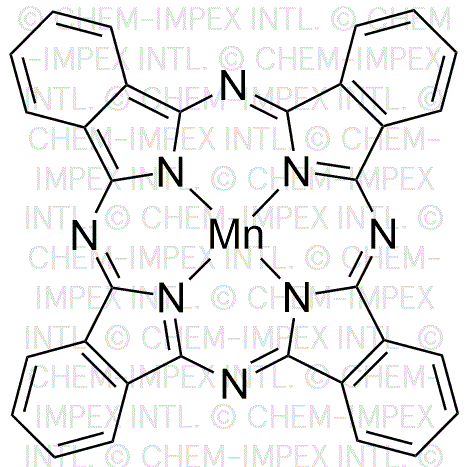Manganese(II) phthalocyanine is widely utilized in research focused on:
- Catalysis: This compound serves as an effective catalyst in various chemical reactions, particularly in the oxidation of organic substrates. Its stability and efficiency make it a preferred choice in industrial processes.
- Electrochemistry: Manganese(II) phthalocyanine is used in the development of electrochemical sensors. Its ability to facilitate electron transfer enhances the sensitivity and selectivity of sensors for detecting environmental pollutants.
- Photodynamic Therapy: In the medical field, this compound is explored for its potential in photodynamic therapy, a treatment for certain types of cancer. Its ability to generate reactive oxygen species upon light activation can target and destroy cancer cells.
- Organic Solar Cells: This chemical is incorporated into organic photovoltaic devices, improving their efficiency. Its light-absorbing properties contribute to better energy conversion rates compared to other materials.
- Textile Dyes: Manganese(II) phthalocyanine is also used in the textile industry as a dye. Its vibrant color and stability under various conditions make it suitable for coloring fabrics and materials.
General Information
Properties
Safety and Regulations
Applications
Manganese(II) phthalocyanine is widely utilized in research focused on:
- Catalysis: This compound serves as an effective catalyst in various chemical reactions, particularly in the oxidation of organic substrates. Its stability and efficiency make it a preferred choice in industrial processes.
- Electrochemistry: Manganese(II) phthalocyanine is used in the development of electrochemical sensors. Its ability to facilitate electron transfer enhances the sensitivity and selectivity of sensors for detecting environmental pollutants.
- Photodynamic Therapy: In the medical field, this compound is explored for its potential in photodynamic therapy, a treatment for certain types of cancer. Its ability to generate reactive oxygen species upon light activation can target and destroy cancer cells.
- Organic Solar Cells: This chemical is incorporated into organic photovoltaic devices, improving their efficiency. Its light-absorbing properties contribute to better energy conversion rates compared to other materials.
- Textile Dyes: Manganese(II) phthalocyanine is also used in the textile industry as a dye. Its vibrant color and stability under various conditions make it suitable for coloring fabrics and materials.
Documents
Safety Data Sheets (SDS)
The SDS provides comprehensive safety information on handling, storage, and disposal of the product.
Product Specification (PS)
The PS provides a comprehensive breakdown of the product’s properties, including chemical composition, physical state, purity, and storage requirements. It also details acceptable quality ranges and the product's intended applications.
Certificates of Analysis (COA)
Search for Certificates of Analysis (COA) by entering the products Lot Number. Lot and Batch Numbers can be found on a product’s label following the words ‘Lot’ or ‘Batch’.
*Catalog Number
*Lot Number
Certificates Of Origin (COO)
This COO confirms the country where the product was manufactured, and also details the materials and components used in it and whether it is derived from natural, synthetic, or other specific sources. This certificate may be required for customs, trade, and regulatory compliance.
*Catalog Number
*Lot Number
Safety Data Sheets (SDS)
The SDS provides comprehensive safety information on handling, storage, and disposal of the product.
DownloadProduct Specification (PS)
The PS provides a comprehensive breakdown of the product’s properties, including chemical composition, physical state, purity, and storage requirements. It also details acceptable quality ranges and the product's intended applications.
DownloadCertificates of Analysis (COA)
Search for Certificates of Analysis (COA) by entering the products Lot Number. Lot and Batch Numbers can be found on a product’s label following the words ‘Lot’ or ‘Batch’.
*Catalog Number
*Lot Number
Certificates Of Origin (COO)
This COO confirms the country where the product was manufactured, and also details the materials and components used in it and whether it is derived from natural, synthetic, or other specific sources. This certificate may be required for customs, trade, and regulatory compliance.


